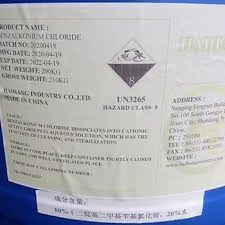pac poly aluminum chloride
Understanding PAC Poly Aluminum Chloride
Poly Aluminum Chloride, commonly referred to as PAC, is a versatile and widely used chemical compound in the realm of water treatment and purification. Its applications span across various industries, including municipal water supply, wastewater treatment, as well as in the food and beverage sector. This article examines the characteristics, benefits, and applications of PAC, highlighting why it is an essential component in modern water treatment practices.
What is PAC?
PAC is a type of coagulant that is produced by the partial hydrolysis of aluminum chloride. It appears as a white to yellowish powder or granules, and its chemical formula can vary due to the varying degrees of polymerization that occur during its formation. The degree of polymerization and the specific formulation can influence its efficacy and suitability for different applications. PAC is favored for its high charge density, which enhances its ability to bind with various contaminants in water.
The Mechanism of Action
The primary function of PAC in water treatment is to facilitate the coagulation and flocculation process. When added to water, PAC dissociates into Al3+ ions, which are positively charged. These ions neutralize the negative charges on suspended particles (such as silt, clay, and organic matter), promoting their aggregation into larger flocs. This process not only improves the removal of these particles during sedimentation but also enhances the overall clarity of the water.
Moreover, PAC is known for its rapid dissolution properties, which allows it to work effectively in both low and high turbidity conditions. Its effectiveness over a broader pH range makes it an ideal choice compared to traditional aluminum sulfate, particularly in industrial applications where water characteristics can vary.
Benefits of Using PAC
1. Improved Water Quality The use of PAC can significantly enhance the quality of treated water. It effectively removes a wide range of impurities, including heavy metals and organic contaminants.
2. Cost-Effectiveness Although the initial cost may be higher than some traditional coagulants, PAC can lead to reduced operational costs due to its effectiveness and lower dosage requirements. It also reduces the volume of sludge produced, further decreasing disposal costs.
3. Versatility PAC can be used in various applications, from drinking water purification to industrial wastewater treatment and in the paper industry as a deinking agent.
pac poly aluminum chloride

4. Safety PAC is generally considered safe to use in drinking water treatment, with regulatory approvals in many countries. Its reduced toxicity compared to other coagulants adds to its appeal.
5. Ease of Use The handling and storage of PAC are more straightforward than some other chemical alternatives, making it suitable for many treatment facilities.
Applications in Different Industries
PAC’s versatility leads to a broad range of applications
- Municipal Water Treatment With a focus on providing safe drinking water, PAC is a key player in municipal water treatment plants, ensuring compliance with health and safety regulations.
- Wastewater Treatment Industrial facilities utilize PAC to treat effluents before discharge, helping to meet environmental regulations and ensuring that harmful contaminants are adequately removed.
- Food and Beverage Industry In the production of beverages, PAC is used to clarify and purify water, ensuring that the final product meets quality standards.
- Pharmaceutical Industry The pharmaceutical sector also employs PAC in the purification of water, as it meets stringent regulatory demands for water quality.
Conclusion
In summary, Poly Aluminum Chloride stands out as a critical agent in water treatment scenarios. Its ability to effectively remove impurities, cost-efficiency, and adaptability across various sectors underscore its value. As the demand for clean water continues to rise globally, the usage of PAC will likely expand, contributing to more sustainable and efficient water treatment practices. Understanding and harnessing the potential of PAC can lead to significant advancements in ensuring safe and clean water for communities and industries alike.
-
lk-319-special-scale-and-corrosion-inhibitor-for-steel-plants-advanced-solutions-for-industrial-water-systemsNewsAug.22,2025
-
flocculant-water-treatment-essential-chemical-solutions-for-purification-processesNewsAug.22,2025
-
isothiazolinones-versatile-microbial-control-agents-for-industrial-and-consumer-applicationsNewsAug.22,2025
-
scale-inhibitor-key-solutions-for-water-system-scale-preventionNewsAug.22,2025
-
organophosphonates-versatile-scale-inhibitors-for-industrial-water-systemsNewsAug.22,2025
-
scale-and-corrosion-inhibitor-essential-chemical-solutions-for-water-system-maintenanceNewsAug.22,2025





